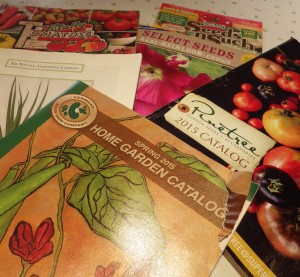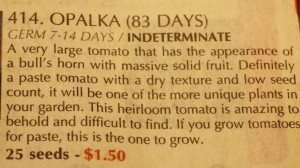 Good day, folks. I know you are veritably bristling with excitement over the upcoming gardening season, champing at the bit, so to speak. And, for the ‘old-timers’ out there, what I’m going to discuss today might seem old stuff, so you might as well go pour yourself a cup of tea, coffee or perhaps something stronger (hey, it’s been a really cold week here in the US – in Tampa, Florida, it was 36 degrees F at one point. The rest of us here in the northeast have had to sing praises when it hit positive numbers).
Good day, folks. I know you are veritably bristling with excitement over the upcoming gardening season, champing at the bit, so to speak. And, for the ‘old-timers’ out there, what I’m going to discuss today might seem old stuff, so you might as well go pour yourself a cup of tea, coffee or perhaps something stronger (hey, it’s been a really cold week here in the US – in Tampa, Florida, it was 36 degrees F at one point. The rest of us here in the northeast have had to sing praises when it hit positive numbers).
For the rest of you out there who are beginners or who have not been involved in vegetable gardening for very long, this, my little dear ones, is for YOU.
First, a seed catalog – that is to say, a printed, get-it-in-the-mail document – is actually filled with information. Some of it will actually not necessarily be useful for you (yet – hey, your old Aunty has been raising veggies for over 50 years, and I learn new stuff out of catalogs every year), but there are items which will help you weed through what can seem to be an overwhelming amount of varieties of various vegetables. Second, even once you’ve come to grips with your choices, you might need a piece of information which will NOT be found in your catalog. I only started using this sort of information myself about 5 years ago and it has changed my gardening dramatically and we’ve had more success because of it. Since this second piece of information actually informs and frames what your growing season is actually going to look like (not necessarily on a day by day basis, but certainly month by month), we’re going to explore that first. This is the long-range weather forecast for your region or area.
About five years ago, I started looking at some long-range weather sites and found one which, at least for my region (sorry to say, I don’t follow anyone else’s region; if you have used this site and it’s let you down, let me know), has been spot on for five years in a row. Knowing if we’re going to have a warm, early spring gives me a shot at getting veggies like lettuces, cabbage family crops, beet family crops and so on into the ground in April instead of May. Knowing if we’ll have a cool, wet summer let’s me know that my chances of getting away without tomato blight is almost in the minus numbers, so I need to choose tomato varieties which are blight resistant (or, as blight resistant as I can get). If the site is predicting a cool early fall with early frosts, I need to make sure that crops such as tomatoes and peppers are chosen accordingly.
This year, my favorite long-range weather site Long Range Weather is indicating the following for my area (and you can get pretty close to where you are gardening on the city link where you can put in a mileage circumference around a specific postal zip code):
Month…………….Average Temperatures…………………Average Precipitation
February………….Cooler than normal…………………..Dryer than normal (less snow)
March…………….Warmer than normal…………………..Wetter than normal (more snow)
April…………….Warmer than normal…………………..Normal
May………………Cooler than normal…………………..Normal
June……………..Cooler than normal…………………..Slightly dryer than normal
July……………..Cooler……………………………..Dryer
August……………Cooler than normal…………………..Dryer than normal
September…………Cooler than normal…………………..Dryer than normal
And that’s the end of my growing season up here, so I shall not go further.
So, what does this tell me:
Early spring season: Two things stand out here – February is going to be dryer than the norm in terms of snow cover, which means that we’re going into March with very possibly very little snow on the tops of the vegetable beds. On the one hand, that’s BAD since it means that we could possibly be going into the summer already in a soil moisture deficit and as we can see from the rest of the chart, once we hit June, we are going to be drying out and will probably have to mulch and water (more on that in a later post), especially for veggies like tomatoes, onions, garlic, potatoes and so on. On the other hand, they are predicting more snow in March, which can work to our advantage – especially since they are saying it will be warmer, so that snow will basically melt off. April will be warmer still, so this means to me that I’ve got a good shot at an early season, which is very nice. I’ll pull out the seeds for chard, beets, lettuces and various greens, cabbage, cauliflower, broccoli, Chinese cabbages and kale and get those ready. If I can get things shoveled off and warmed up to 50 degrees F. in late March, I will direct seed these into the garden and they will, with a bit of protection from plastic or row cover, get a good jump on the spring during a time when there is actually moisture in the soil. The other thing is this: if May is going to be cooler,then we might be able to keep these crops in the ground a bit longer than usual; with any luck, they won’t bolt.
Late spring and summer season: As I discussed before, what we’ve got facing us this year is going to be cooler weather and dryer weather. Where I live has plenty of water (we’re positively oozing with underground springs and hydrostatic pressure here), so I can supplement whatever we will get. That is not an issue. The cooler temperatures ARE. What this means is that a) we will probably have more cloudy days than normal (which up here is saying something since people are literally sent up here if they have skin issues from sun exposure), and b) We won’t get any help in terms of developing sugars and ripening for plants such as tomatoes and peppers. So, we need to choose the shortest season varieties that we can find to give us the best shot of having actual ripened tomatoes and peppers this year.
So, now I know the ‘lay of the land’ so to speak. How do I use my seed catalogs to choose appropriate varieties?
First: Seed catalogs are filled with ‘red flag’ words, words and phrases that the marketers have put into the descriptions to tip you off. Since I may be working with iffy (on a day by day basis) weather conditions for the early spring period, I’m going to be looking for words and phrases such as:
Early spring sowing
Cold soil conditions
Forgiving
Frost tolerant
and so on.
For folks with hot conditions, you are looking for phrases such as ‘slow to bolt’, tolerant of hot dry conditions, and so on.
 Second: The varieties themselves, in their description, will provide more, or less information. I’ll use this particular tomato, Opalka, as an example. In the photo here, the catalog is providing the usual glowing copy, but it’s also providing information on growing time, that is, the number of days it will take to get ripe fruit (on average) from day 1 (that is, the date when you plant the item in the ground – and in the cases of tomatoes, peppers and the like, they are referring to planting PLANTS, not seeds, so plan accordingly). So, this copy is telling me first, that it takes 83 days (or almost 12 weeks) from the date I put a plant into the ground, until I get to pick red tomatoes. Just under that, it says that the seeds take between 1 and 2 weeks to germinate. Now, it usually takes 4-6 weeks to get a tomato plant to a size that you want to put in the garden. So, let’s start counting, shall we? At minimum, we’ve got:
Second: The varieties themselves, in their description, will provide more, or less information. I’ll use this particular tomato, Opalka, as an example. In the photo here, the catalog is providing the usual glowing copy, but it’s also providing information on growing time, that is, the number of days it will take to get ripe fruit (on average) from day 1 (that is, the date when you plant the item in the ground – and in the cases of tomatoes, peppers and the like, they are referring to planting PLANTS, not seeds, so plan accordingly). So, this copy is telling me first, that it takes 83 days (or almost 12 weeks) from the date I put a plant into the ground, until I get to pick red tomatoes. Just under that, it says that the seeds take between 1 and 2 weeks to germinate. Now, it usually takes 4-6 weeks to get a tomato plant to a size that you want to put in the garden. So, let’s start counting, shall we? At minimum, we’ve got:
1 week to germinate
4 weeks to make a plant to planting size
12 weeks to get tomatoes to harvest
Total: 17 weeks.
Maximum:
2 weeks for germination
6 weeks for a plant big enough to put into the garden
14 weeks to get tomatoes to harvest
Total: 22 weeks.
Our usual killer frost is last week of September to the first week of October (and with the number of months there saying ‘cooler’, I’m going to go with late September as my deadline).
September..5 weeks
August…..4 weeks
July…….5 weeks
June…….4 weeks
May……..5 weeks
April……4 weeks
March……4 weeks
Now, I would never, EVER put tomatoes (or peppers or eggplants) into the ground before the soil temperatures were good and warm and the chances of a frost were basically minimalized and that is mid-late May. The total number of weeks from June through the end of September are 18 weeks, which is giving me enough time from Day 1 to Frost time. But when should I start the seeds?
At minimum, we’re looking at 5 weeks; at maximum, it’s 7 weeks. So, the earliest I would want to plant seeds for this tomato is going to be end of March/beginning of April.
Since growing a tomato seed to the size where I’d want to put it in the garden is pretty much the same, no matter HOW LONG it takes for the plant to produce and ripen tomatoes, then the only wiggle spot I’ve got in determining which varieties I’m going to grow is in that figure at the top of 83 Days – that is, the time between when I transplant the plants and get to harvest. So, given our situation this year, I want to find tomatoes which are ‘short season’.
Some varieties which qualify are:
Grape/Cherry tomatoes: Tiny Tim (45 days), Gold Nugget (55 days) and Matt’s Wild Cherry (55 days)
Standard Hybrid tomatoes: Polbig (56 days), Golden Girl (69 days), Early Girl (60 days), and ClusterGrand (63 days)
Standard Heirloom and Open Pollinated: Subartic Plenty (62 days), Taxi (64 days), Peron(68 days), Oregon Spring (68 days), Black Krim (69 days)Stupice (65 days)
Paste tomatoes: Polish Linguisa (78 days), Martino’s Roma (75 days)
If you have your own short-season tomatoes that are your favorites, what do you grow?
